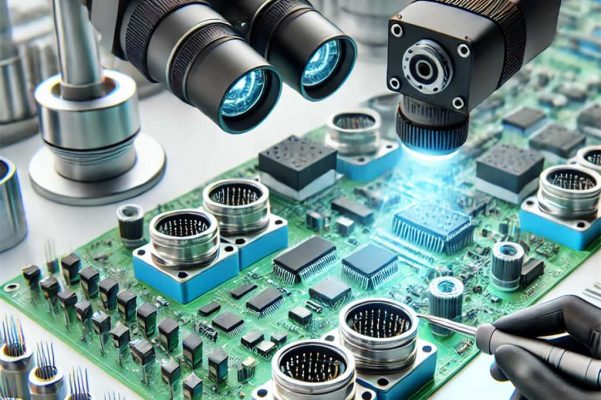With Industry 4.0’s advancement, manufacturing is undergoing a major transformation. Automated production lines are now essential in modern manufacturing. They help improve efficiency, reduce costs, and enhance product quality. Among these systems, connector assembly plays a crucial role. Connectors are key components in electronic, mechanical, and communication systems. Their assembly directly impacts the product’s performance and reliability.
Companies like Konnra are leading these innovations. Konnra designs and produces high-performance connectors for automated production lines. They use advanced technology in precision manufacturing. Konnra ensures their connectors are reliable and optimized for efficient assembly. This reduces errors and downtime. Their expertise covers industries like automotive, consumer electronics, and telecommunications. In these fields, precision and quality are crucial.

Ⅰ. Basic Concepts and Types of Connector Assembly
Connectors are widely used in various industries. These include automotive, aerospace, electronics, and communication devices. Their main function is to transmit and convert electrical or optical signals. The assembly process for connectors involves many precise steps. These include soldering, crimping, pin insertion, locking, and housing installation.
Connectors can be classified based on their applications:
Electrical Connectors: Used for electrical signal transmission. Common in power systems and electronic devices.
Optical Fiber Connectors: Used for optical signal transmission. Common in communication equipment and data centers.
RF Connectors: Used for high-frequency signal transmission. Found in communication, radar, and navigation equipment.
Hybrid Connectors: These handle both electrical and optical signals. They are used in high-end electronic systems.
In automated production, the assembly process varies by connector type. But generally, it involves precision machining, soldering, and testing.
Ⅱ. Key Technologies in Connector Assembly
- Automated Assembly Systems
Automation is key for improving efficiency and quality in connector production. Precise robotic arms and sensors assemble each connector component. Common automated processes include:
- Pin Assembly: Pins are core components of connectors. Their precision impacts signal transmission. Automated systems insert pins with vision guidance and precise positioning.
- Crimping and Soldering: Automated crimping ensures secure terminal connections. Soldering controls temperature and time for consistent quality.
- Vision Guidance and Inspection Systems
Connector assembly requires high precision, especially for micro-connectors or optical fiber connectors. Vision systems guide robots in positioning components accurately. Automated inspection uses cameras, lasers, and sensors. These systems check for errors like bent pins or incomplete soldering. They ensure each product meets strict quality standards.
- High-Precision Crimping Technology
Crimping is critical in connector assembly. It directly affects signal transmission. Automated equipment uses sensors to apply correct pressure during crimping. This avoids over-crimping or incomplete crimping.
- Continuous Crimping: This technology allows continuous feeding and crimping. It improves efficiency by reducing assembly time.
- Multi-Axis Robotic Technology
Multi-axis robots are essential in connector assembly. They perform complex tasks like material handling, assembly, and soldering. These robots work with sensors and vision systems for precise assembly. In optical fiber connector assembly, robots handle delicate cables with extreme precision.
- Modular and Customizable Production
As connector applications diversify, customer requirements vary. Modular designs in automated lines adapt to different specifications. Customizable systems handle small-batch, multi-variety products. This is especially important for high-end connectors.
Ⅲ. Challenges in Connector Assembly
Despite automation’s benefits, challenges remain in connector assembly.
- Precision and Miniaturization Trends
As devices get smaller, connectors become more compact. Performance demands are higher. Pin pitch in micro-connectors can be as small as 0.5mm. Optical fiber connectors have diameters only a few microns. Automated systems need extreme precision to handle these components. High-resolution vision systems and precise robots are crucial for this task.
- Integration of Multiple Materials and Complex Structures
Modern connectors use materials like metal, plastic, and ceramic. Their structures are more complex. Assembly often requires multiple processes. Some high-performance connectors need precise coatings for better conductivity. This increases the need for flexibility in automated production.
For companies like connector factory, scalable solutions are key to handling complex tasks efficiently.
- Static Electricity and Environmental Control
Connectors are sensitive to static electricity. Static discharge can damage components during high-precision assembly. Controlling static, temperature, and humidity is essential. This is especially true for manufacturers like
china power connector companies.
Ⅳ. Future Trends and Development
As smart manufacturing evolves, connector assembly automation will become more advanced.
- Application of Artificial Intelligence and Machine Learning
AI will play a key role in future connector assembly. Machines can adjust assembly parameters based on historical data. This optimizes production and improves quality. Machine learning can predict quality issues and make real-time adjustments. AI also helps with machine maintenance, reducing downtime.
- Smart Sensors and Real-Time Monitoring
Smart sensors improve precision and stability in connector assembly. They monitor key parameters like pressure and temperature. This ensures that every connector meets quality standards. Real-time monitoring helps companies track production progress. It reduces waste and improves efficiency.
- Collaborative Robots and Human-Robot Collaboration
Collaborative robots, or Cobots, are becoming more common in connector assembly. They are more flexible than traditional robots. Cobots work alongside humans to complete complex tasks. This improves production flexibility. It’s especially useful for small-batch products like adapter connector types.
Conclusion
Connector assembly is a crucial part of modern manufacturing. Technologies like multi-axis robots and vision systems have improved efficiency. However, challenges remain as devices continue to miniaturize. Future innovations like AI and Cobots will make connector assembly smarter and more efficient. Continuous innovation will drive the manufacturing sector toward a more intelligent future.









